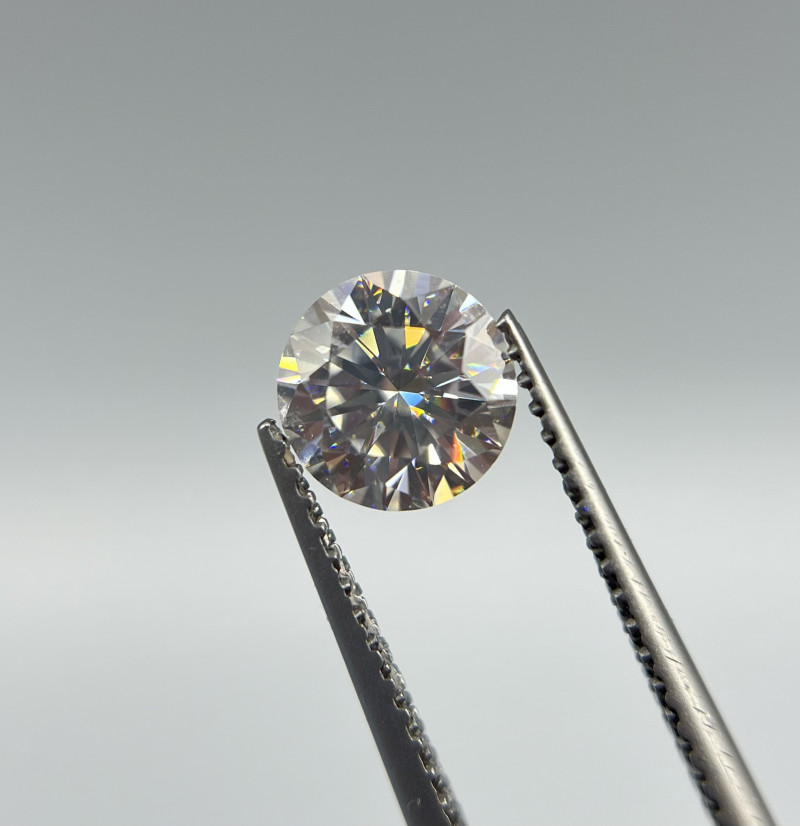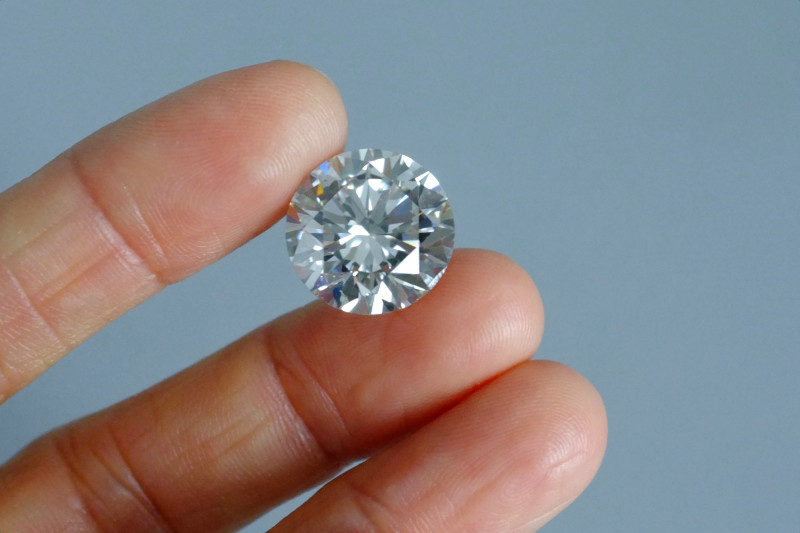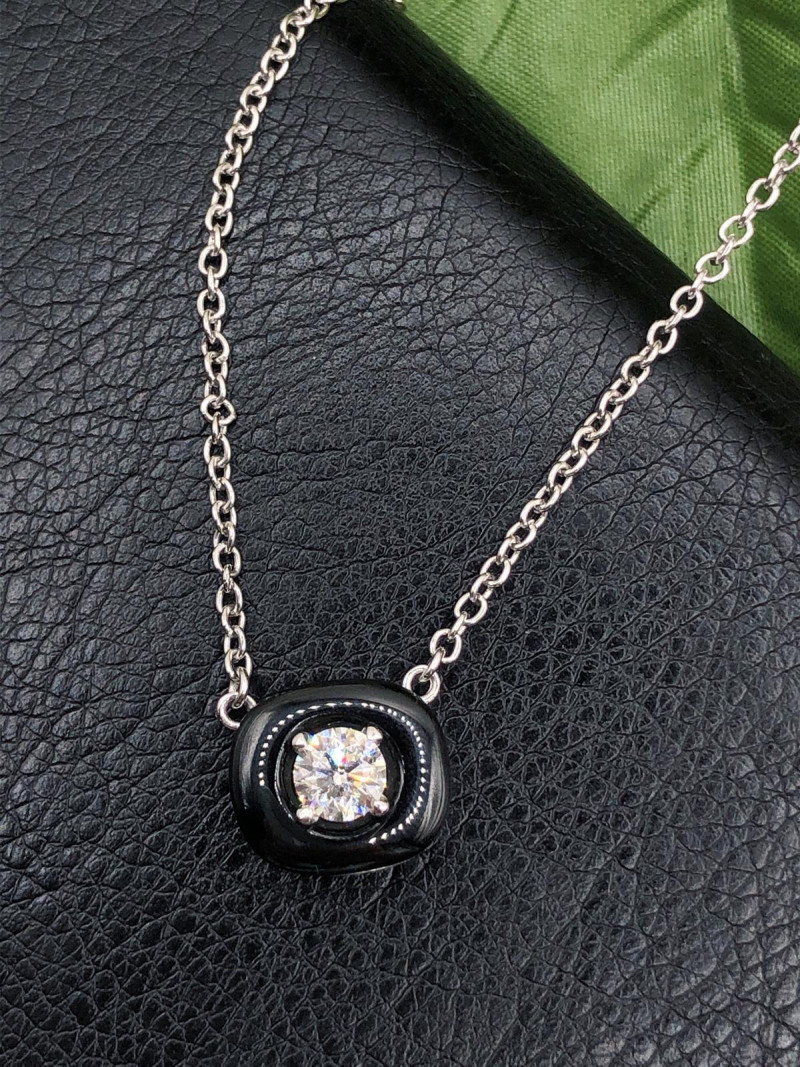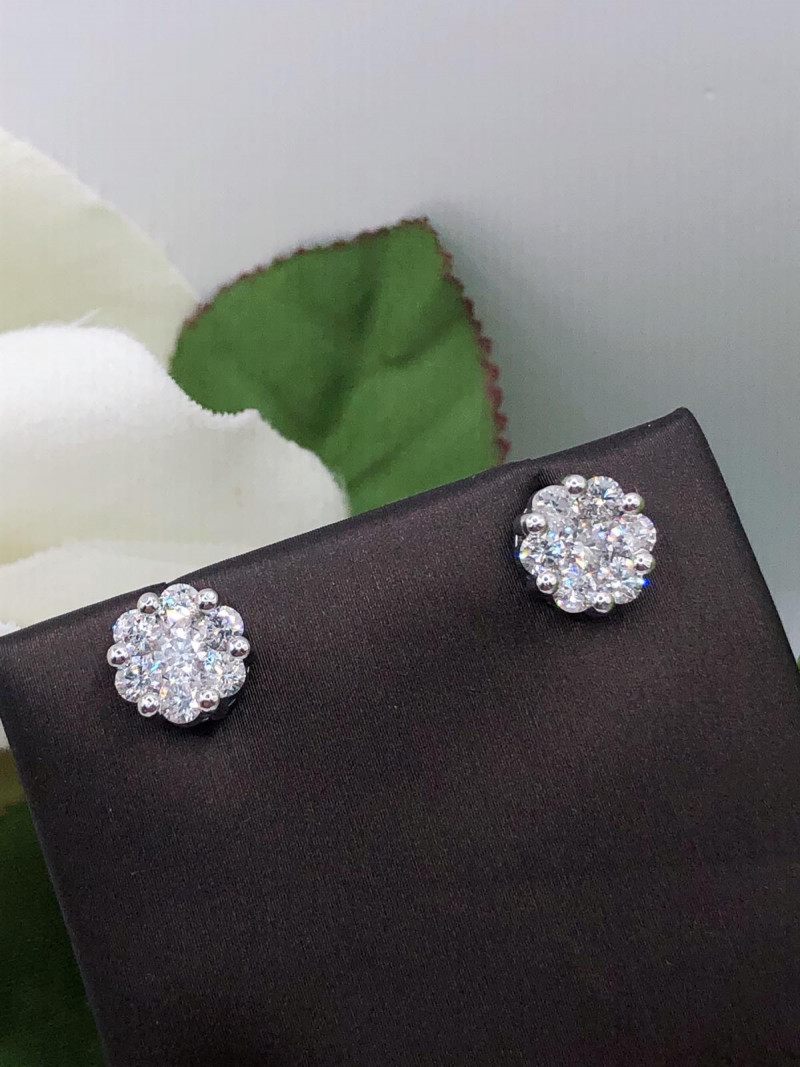
¿Qué es un diamante moissanita? Valor, propiedades, ventajas y desventajas
 La moissanita es una piedra preciosa incolora y transparente que se suele utilizar como alternativa al diamante. Por este motivo, a veces se la denomina “diamante moissanita”, aunque se trata de una piedra completamente distinta.
La moissanita es una piedra preciosa incolora y transparente que se suele utilizar como alternativa al diamante. Por este motivo, a veces se la denomina “diamante moissanita”, aunque se trata de una piedra completamente distinta.
Aunque existe moissanita formada naturalmente, prácticamente todas las gemas de moissanita disponibles hoy en día son sintéticas (creadas en un laboratorio).
Existen muchas alternativas a los diamantes, ya sea para anillos de compromiso u otras joyas con diamantes. Algunos ejemplos son la circonita cúbica, el circón y el zafiro. En los últimos años, la moissanita ha escalado posiciones como una de las principales alternativas a los diamantes.
Pero, ¿qué es la moissanita? ¿De dónde proviene y cómo se compara con el diamante? ¡Responderemos a todas tus preguntas en esta guía sobre la moissanita!

¿Qué es la moissanita?
La moissanita es un mineral de carburo de silicio descubierto por primera vez en un cráter de meteorito en Arizona, EE. UU. La moissanita natural es increíblemente rara y, hasta ahora, solo se encuentra en meteoritos y, ocasionalmente, en el manto superior de la Tierra.
Debido a su rareza, el mercado ha recurrido a la moissanita sintética.
Otros términos para “sintético” incluyen “artificial”, “creado en laboratorio” y “creado en laboratorio”. La moissanita sintética, como cualquier piedra preciosa sintética, se crea en un laboratorio, pero posee las mismas propiedades físicas y químicas que la moissanita natural.
¿Cómo se fabrica la moissanita?
El proceso de formación de la moissanita natural no está del todo claro, ya que muchas piedras llegaron a la Tierra en meteoritos. Pero los científicos creen que es probable que se forme bajo altas temperaturas y presiones, por lo que estas condiciones se suelen reproducir para crear moissanita sintética.
Aunque los métodos difieren entre laboratorios, uno de los métodos más comunes es el proceso Lely.
El proceso Lely para la moissanita sintética comienza con polvo de carburo de silicio. Este polvo se coloca en un crisol de grafito, un recipiente para calentar o fundir materiales como metales.
A partir de ahí, eliminan el oxígeno y cualquier otro vapor o gas con gas argón. Luego, calientan el crisol a unos 2500 °C (4530 °F). El carburo de silicio se transforma en vapor que se deposita sobre una varilla central de grafito y se enfría gradualmente hasta convertirse en un cristal.
Aunque la creación se ha perfeccionado con el tiempo, todavía se necesitan entre uno y dos meses para fabricar una gema. Algunos productores de renombre son Charles and Colvard, Amora Gems y Harro Gems.
¿Cuáles son las propiedades de la moissanita terminada?
En la imagen de arriba: Cristal de moissanita sintética | Crédito de la imagen: Lamiot; Licencia Creative Commons Attribution-Share Alike 4.0 International
Propiedades minerales de la moissanita
La fórmula de la moissanita, compuesta de carburo de silicio, es SiC. El carburo de silicio, o “carborundo”, tiene una variedad de usos industriales, algunos en el sector de la joyería. En particular, el carborundo se utiliza como semiconductor y abrasivo, pero rara vez se encuentra de forma natural, un enigma que forma parte de la historia de la moissanita.
Si bien la forma incolora es la más conocida, la moissanita también puede formarse naturalmente en amarillo, negro o verde. La moissanita sintética puede ser prácticamente de cualquier color.
Aquí están las otras propiedades minerales de moissanita:
Estructura cristalina : Hexagonal
Brillo : Adamantino a metálico.
Transparencia : Transparente
Índice de refracción : 2,59-2,69
Densidad : 3,21-3,22
Escote : Indistinto en [0001]
Fractura : Concoidea
Raya : gris verdosa
Luminiscencia : A veces fluorescencia débil o moderada; naranja en LW-UV y rara vez SW-UV; termoluminiscente (inducida por calor);
Pleocroísmo : Débil; Azul claro a azul muy claro o índigo.
Dejando a un lado la mineralogía, ¿de dónde se originó la moissanita?
Historia de la moissanita
El químico francés Dr. Henri Moissan descubrió la moissanita en 1893. Mientras buscaba un cristal para uso industrial, terminó en Canyon Diablo, Arizona, EE. UU., donde encontró pequeñas piedras que confundió con diamantes en un antiguo cráter de meteorito.
Mientras tanto, en 1890, el químico estadounidense Edward Acheson intentaba crear diamantes sintéticos, pero accidentalmente fabricó carburo de silicio, al que denominó “carborundo”. Este proceso se convirtió en el “Proceso Acheson”.
En 1904, Moissan se dio cuenta de que sus muestras eran carburo de silicio natural. En 1905, el gemólogo de Tiffany, George Kunz, bautizó la piedra como “moissanita” en honor a Moissan.
Las primeras fuentes no meteóricas de moissanita natural reportadas surgieron en la década de 1950, dentro de rocas en Wyoming, EE. UU., y Yakutia, Rusia.
Desde 1987, Cree Research, Inc. en Carolina del Norte ha sido pionera en la fabricación en masa de moissanita sintética.
¿Cuánto tiempo lleva la moissanita en el mercado? La moissanita está disponible para el público en general desde 1995, cuando la empresa C3, Inc. (ahora Charles & Colvard) comercializó por primera vez la moissanita sintética.
Sin embargo, las primeras gemas sintéticas de moissanita surgieron alrededor de 1980. Durante años, solo los joyeros y coleccionistas conocían la moissanita. Muchos decidieron no intentar comercializarla ni venderla debido a la competencia que supondría para su producto estrella: los diamantes.
Según una investigación de 2021 de The Knot, la moissanita es la segunda opción más popular para las piedras de los anillos de compromiso después del diamante, aumentando un 9 por ciento (desde 2019) como opción de piedra preciosa sin diamante.
Pero ¿cómo se comparan las moissanitas y los diamantes?
 En la imagen de arriba: piedra preciosa de moissanita blanca
En la imagen de arriba: piedra preciosa de moissanita blanca
 En la imagen de arriba: piedra preciosa de diamante blanco.
En la imagen de arriba: piedra preciosa de diamante blanco.
Moissanita vs. diamante
Si observas una moissanita y un diamante uno al lado del otro, pueden parecer indistinguibles.
¿Puedes diferenciar entre un diamante y una moissanita? Solo si eres un experto capacitado y cuentas con las herramientas adecuadas. Incluso con un bolígrafo probador de diamantes estándar, la moissanita a menudo pasará por un diamante.
Entonces, ¿cuáles son las diferencias entre la moissanita y el diamante?
Color y claridad
La moissanita, al igual que el diamante, es tradicionalmente incolora, pero suele tener matices entre amarillentos y marrones. Ambas piedras pueden tratarse para eliminar los matices evidentes.
La moissanita incolora puede parecer algo azul o verde bajo la luz natural, así que siempre mírela bajo diferentes fuentes de iluminación antes de comprarla.
Tanto las moissanitas como los diamantes están disponibles en prácticamente cualquier color, aunque la mayor parte de la gama de colores más brillantes de la moissanita proviene de tratamientos. Aun así, las moissanitas de mayor valor son las más incoloras.
En términos de claridad, los diamantes y las moissanitas se clasifican en escalas de claridad similares y sus grados dependen de las inclusiones visibles.
Dado el refinado proceso de creación de la moissanita, la mayoría tendrá una gran claridad. Mientras tanto, los diamantes naturales con la misma claridad son más raros y más caros.
Aquí hay un dato curioso relacionado: ¡se ha encontrado moissanita como inclusión en diamantes!
Brillar
Si bien el corte correcto puede generar el máximo brillo, las propiedades físicas inherentes de una gema también juegan un papel.
El brillo es la luz blanca que se refleja desde el interior de la piedra. Un índice de refracción más alto significa un mayor brillo, y la moissanita se destaca con un índice de refracción de 2,59-2,69 (en comparación con el de los diamantes, que es de 2,41-2,42).
La dispersión , o fuego, es la cantidad de luz de colores que refleja una gema. La dispersión de la moissanita es de 0,104, ¡más del doble del fuego del diamante, que es de 0,044!
Otro factor a tener en cuenta es la birrefringencia o doble refracción. Algunas piedras tienen dos índices de refracción, lo que permite el pleocroísmo. La moissanita es birrefringente, mientras que el diamante no lo es.
Un aspecto importante de la moissanita que hay que tener en cuenta es su efecto de “bola de discoteca” . Algunos compradores consideran que su brillo tipo arcoíris es demasiado llamativo o de mal gusto, mientras que otros afirman que genera más cumplidos que los que recibieron con sus anillos de diamantes.
Durabilidad
Probablemente sepas que los diamantes son las piedras preciosas más duras, con un grado de dureza de 10 en la escala de Mohs . Pero ¿la moissanita es duradera? ¡Sí!
La moissanita se sitúa justo por debajo del diamante en cuanto a dureza, entre 9,25 y 9,5, ¡más alta que el rubí y el zafiro !
Sin embargo, la dureza es sólo resistencia al rayado.
La tenacidad es la resistencia de una gema a romperse o astillarse. Los diamantes tienen una tenacidad frágil, mientras que las moissanitas tienen una tenacidad excelente.
La exfoliación describe la facilidad con la que una gema se partirá a lo largo de ciertos ejes (planos de exfoliación). La exfoliación perfecta es la más fácil de dividir, y los diamantes tienen una exfoliación perfecta en cuatro direcciones, lo que los hace vulnerables a la fragmentación o incluso a la rotura si reciben un golpe en cualquiera de esos cuatro ángulos.
Por el contrario, la moissanita tiene una exfoliación indistinta (es más difícil de partir) en una dirección, lo que la hace menos vulnerable a la rotura.
Por supuesto, también tenemos que considerar otros tipos de daños.
Ética
Si bien existen ventajas tanto para las piedras preciosas naturales como para las sintéticas , uno de los beneficios de las piedras preciosas sintéticas es que evitan los impactos ambientales dañinos y las prácticas laborales a menudo poco éticas de la minería.
Dicho esto, no todo es blanco o negro. Las condiciones de las minas, en particular las de gran escala, a veces pueden ser peligrosas, pero la minería es una fuente establecida de ingresos para muchas personas en los países en desarrollo. Además, su industria minera ofrece una fuente de financiación federal para desarrollos muy necesarios.
Por lo tanto, las gemas creadas en laboratorio no son cien por ciento más éticas que las gemas naturales. Será necesaria una transformación de la industria a gran escala para ayudar a esas comunidades mineras (en lugar de simplemente cambiar a un nuevo tipo de producción) a garantizar un resultado ético.
Usted puede hacer su parte eligiendo un proveedor con fuentes de extracción éticas, lo que implica condiciones de trabajo seguras, un impacto ambiental mínimo y salarios justos.
Puede consultar nuestra guía sobre moissanita frente a diamantes para obtener un desglose más completo de estas diferencias.
Una diferencia que no mencionamos anteriormente es el precio.

Precio y valor de la moissanita
En primer lugar, ¿la moissanita es más cara que el diamante? No, todo lo contrario. Las moissanitas suelen costar un 10 por ciento más que los diamantes de la misma calidad.
Bueno, ¿los “diamantes” de moissanita valen algo? Definitivamente. Las moissanitas no son tan asequibles como algunas alternativas a los diamantes, como la circonita cúbica, pero la moissanita tiene una mayor durabilidad que otras alternativas.
Comparemos una versión de moissanita de 1 quilate, incolora y de talla redonda con un diamante. Este tipo de diamante se vende por entre 2000 y 25 000 dólares, mientras que este tipo de moissanita se vende por aproximadamente entre 450 y 600 dólares.
¿Está interesado en una opción más colorida? El precio mayorista de las moissanitas de colores es incluso más bajo: de $10 a $80 para las piedras de 1 quilate. Los anillos de moissanita de 0,5 a 1 quilate cuestan entre $35 y $90 al por mayor y menos de $250 en general.
¿Qué pasa con los diamantes sintéticos ? El precio promedio de un diamante sintético de 1 quilate es de $800 a $1,000 por quilate, mucho más alto que el de la moissanita sintética.
¿Dónde puedo comprar moissanita?
Uno de los problemas de la moissanita, especialmente en comparación con los diamantes, es su disponibilidad limitada. Casi todos los minoristas de joyería tienen diamantes disponibles, pero no ocurre lo mismo con la moissanita.
Desde que se ha incrementado el conocimiento sobre la moissanita, más minoristas como Kohl's y Amazon han comenzado a ofrecerla. El principal problema es la compra en persona; encontrar moissanitas en tiendas físicas puede ser difícil.
Por supuesto, existen ventajas y desventajas de comprar en línea frente a comprar en persona.
Aproximadamente el 90 por ciento de las parejas compran anillos de compromiso en persona, según Richline Digital, pero el costo de los diamantes en la tienda es generalmente entre un 40 y un 50 por ciento más alto que en línea.
Una de las principales desventajas de comprar online es no poder probártelo y verlo bajo una iluminación diferente.
En última instancia, depende de las preferencias personales.
¡Ahora, analicemos algunas de las muchas formas emocionantes en que puedes usar la moissanita!
Tipos de joyas de moissanita
La durabilidad, el precio accesible y la versatilidad de la moissanita la hacen ideal para todo tipo de joyas, incluidas:

Anillos
Como era de esperar, la forma estándar de lucir esta gema es con un anillo de “diamante” de moissanita, ya sea un anillo de compromiso sin diamantes o no.
Las moissanitas se pueden cortar en cualquier forma, y su falta de escote perfecto significa que prácticamente cualquier engaste es razonable: bisel , canasta, garra , lo que sea.
Además, puedes usar el dinero que ahorraste al optar por la moissanita para derrochar en un elaborado estilo pavé , halo o incluso doble halo .

Colgantes y collares
Otra opción popular para las joyas de moissanita es un collar con colgante. La opción más clásica es un collar solitario con una sola moissanita. Pero puedes optar por cualquier diseño, desde una hebra completa de moissanitas hasta collares de moissanita únicos de estilo hip hop.

Pulseras y relojes
Las pulseras de moissanita varían desde las glamorosas pulseras de tenis de moissanita hasta las minimalistas pulseras deslizantes de una sola moissanita. Una pulsera de puño con moissanita incrustada es otro estilo clásico y cautivador.
Los estilos populares para hombres son las pulseras de eslabones cubanos de oro blanco con moissanita o los relojes con incrustaciones de moissanita.

Pendientes
Al igual que los tipos de joyas anteriores, los pendientes de moissanita tienen mucho potencial. Por supuesto, los pendientes de botón de moissanita son el estándar. Pero otros estilos, como los pendientes de aro con tachuelas de moissanita, los pendientes tipo araña o los pendientes tipo cadena, reflejarán el arcoíris desde todos los ángulos.
Independientemente del estilo, el cuidado de la moissanita es crucial para mantenerla brillante (como un diamante, se podría decir).
Limpieza y cuidado de las joyas de moissanita
Afortunadamente, el color y la claridad de la moissanita no se desvanecen. Cualquier opacidad se puede solucionar con una limpieza.
Estos son los pasos para limpiar la moissanita:
En un recipiente, mezcle agua tibia con un detergente líquido suave.
Sumerja un cepillo suave (por ejemplo, un cepillo de dientes) en la mezcla.
Utilice el cepillo para frotar suavemente la moissanita.
Enjuague bien la piedra con agua tibia.
Sécalo con un secador de pelo, un recipiente con arroz o un paño de microfibra.
Puedes usar moissanita en la ducha, pero la acumulación de jabón resultante puede obligar a limpiarla con más frecuencia.
¿El cloro arruina la moissanita? Nadar no afectará a la moissanita, pero el cloro puede afectar los engastes de metal.

¿Listo para maravillarte con la moissanita?
La moissanita es sin duda una excelente alternativa a los diamantes, pero también es mucho más. Esta gema ofrece un brillo que durará toda la vida y puedes sentirte bien al hacer una elección sustentable con esta piedra creada en laboratorio.
¿Listo para comprar? ¡Explora nuestra colección de joyas de moissanita hoy mismo!
Buscar en el Fashion Encyclopedia
Subastas relacionadas
Artículos relacionados
Cómo comprar joyas en Internet. Hay muchos tipos de cuentas. Depende de usted decidir por dónde quiere empezar, si todas son cuentas de piedras preciosas auténticas o si también utilizará cuentas de vidrio "artificiales" y también cuentas de oro y plata.
10th Apr 2019
Cómo comprar un rubí para su anillo o colgante. Asegúrese de aprender todo lo que pueda sobre los rubíes antes de comprar un anillo o un engaste al que vaya a agregar rubíes. Al igual que los diamantes, los rubíes pueden tener defectos e imperfecciones. El rubí es uno de los más
10th Apr 2019
últimos artículos
El titanio es un metal muy utilizado en joyería, conocido por ser ligero, duradero y asequible. Conozca todo sobre el titanio, cómo se compara con otros metales similares y las ventajas y desventajas de las joyas de titanio.
7th Feb 2023
Aprenda todo sobre las joyas de tungsteno: desde su historia y usos hasta su durabilidad y cuidado. Al final de nuestra guía, sabrá si el tungsteno es adecuado para usted.
7th Feb 2023
¿Estás pensando en añadir joyas de oro blanco atemporales a tu colección de accesorios elegantes? ¡Aquí tienes todo lo que necesitas saber sobre el sofisticado oro blanco!
29th Jan 2023




